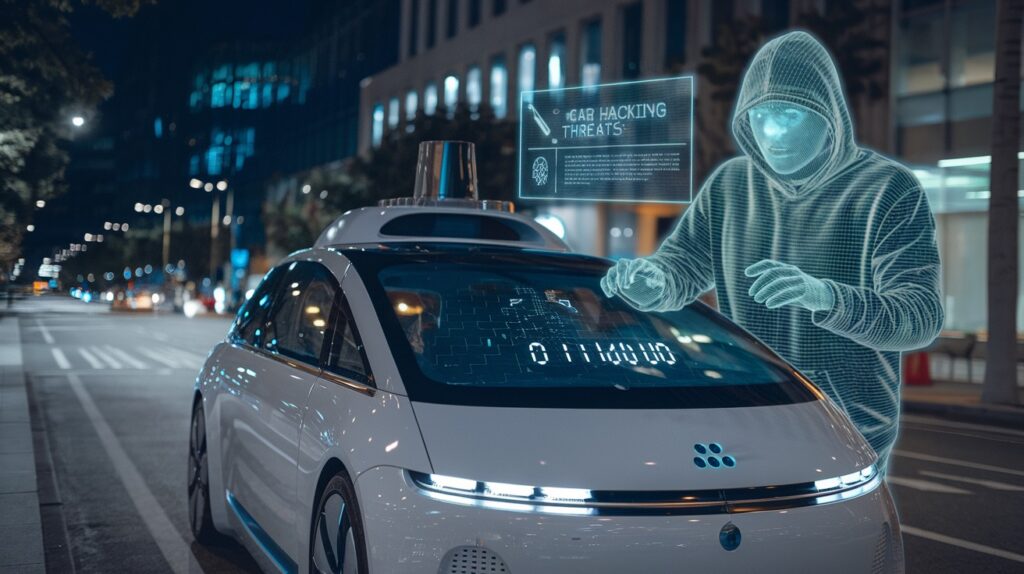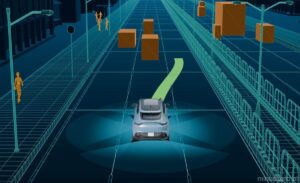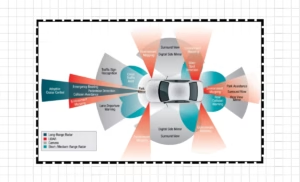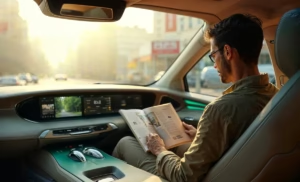Imagine you’re cruising down the highway, hands off the wheel, while your self-driving car handles everything. Suddenly, it swerves. Then it locks its doors and floors the accelerator. This isn’t science fiction—it’s a very real threat in today’s connected world.
Back in 2015, two researchers remotely hijacked a Jeep Cherokee. They turned on the air conditioning, wiped the windshield wipers, and even cut the transmission. Although no crash occurred, that demonstration proved how exposed smart cars can be. Now, millions of connected vehicles roam our roads. Unfortunately, each one could be a hacker’s next target.
Below, you’ll find five ways hackers might seize control of your self-driving ride. Along the way, you’ll see real-world examples, common tactics, and proven defenses. Whether you own a partially automated car or a fully driverless taxi, these tips will help keep you safe.
1. Remote Access and Control Vulnerabilities

First, let’s explore how attackers break in from a distance.
A. Taking Over Core Vehicle Systems
Because self-driving cars stay online 24/7, they face more entry points than you might think. For instance, hackers could hijack:
- Navigation systems. They guide your route and detect detours.
- Safety features. This includes airbags, collision alerts, and auto-braking.
- Electronic Control Unit (ECU). It acts as the car’s “brain” that links all parts.
- On-Board Diagnostics (OBD). Mechanics use it to read error codes.
In one test, criminals used an app flaw to send commands to a car’s ECU. As a result, they controlled the brakes at will.
B. Causing Crashes from Afar
Moreover, attackers don’t need physical access. Once inside, they could:
- Forge road signs. A few printed changes can mislead cameras.
- Jam LiDAR sensors. Lasers or LEDs blind them temporarily.
- Install malware. They slip it in via an unsecured service-center Wi-Fi.
- Disrupt in-car networks. Flooding the CAN bus cuts critical messages.
Consequently, your car could drive into obstacles or ignore pedestrians. Even worse, someone else’s hacked vehicle might crash into yours on purpose.
C. Why More Cars Means Bigger Targets
Every new autonomous vehicle is another possible entry point. In fact:
| Factor | Why It Matters |
|---|---|
| Always-on Internet | It opens cars to online probes |
| Bluetooth pairing | It can let unknown devices connect |
| OTA software updates | One bad patch spreads malware |
| V2V & V2X tech | Hacking one car affects many |
Notably, in 2024 a single supplier flaw froze 2,000 rental EVs in Europe. That one bug caused huge delays and safety concerns.
D. Common Remote Hacking Techniques
Advanced hackers rely on methods like:
- Software backdoors hidden during development
- Man-in-the-Middle (MiTM) attacks that alter data mid-transit
- Denial-of-Service (DoS) to knock out sensors such as radar
- Supply-chain compromises that taint parts before assembly
- Ransomware that locks all on-board systems until ransom is paid
Because of these threats, most automakers now run “secure by design” audits on every software release.
2. Specific Hacks Targeting Smart Vehicles

Next, let’s dive into more focused attacks once hackers gain entry.
A. Cracking Keyless Entry Systems
Keyless entry makes life easier, but it can also make theft simpler. Using “relay attacks,” thieves amplify your key-fob’s signal. Then they unlock and start your car—even if the fob sits inside your house. In 2023 alone, over 15,000 UK cars fell victim to this trick.
B. Stealing Identities via Car Data
Modern vehicles store far more than mileage logs. They record:
- Phone contacts synced through Bluetooth
- Payment details used for tolls or in-car purchases
- Home and work addresses in navigation history
- Voice clips for AI voice assistants
A breach of this data can fuel identity theft. In one incident, hackers accessed a fleet’s telematics server and exposed thousands of drivers’ card numbers.
C. Hijacking Driving Controls
Perhaps the scariest risk: full control of your steering, brakes, or throttle. Researchers have shown they can:
- Spoof GPS signals to reroute cars off course
- Override emergency braking to disable safe stops
- Inject commands into the steering ECU for sudden turns
Even partial control can cause wrecks or trap passengers inside.
D. USB Port Malware Injections
In-car USB ports let you charge phones or update maps. Yet a single infected thumb drive can:
- Auto-run malware on the infotainment system.
- Spread to the ECU via internal networks.
- Harvest logs, contacts, and location history.
One white-hat tester used a USB plug to extract onboard passwords in seconds.
E. Deliberate Sensor Sabotage
Finally, some hackers attack your car from the outside. They might:
- Stick small decals on stop signs to mislead cameras.
- Spray paint road lines in misleading patterns.
- Shine high-powered LEDs into cameras to blind them.
When sensors go dark, cars often halt. In worst cases, they choose unsafe maneuvers.
3. What Makes Autonomous Cars Extra Vulnerable

Even regular vehicles aren’t immune to hacks. Still, driverless cars add fresh angles.
A. Sensor Spoofing and Jamming
Each sensor type—LiDAR, radar, or camera—can be fooled. For example:
- LiDAR spoofing creates fake 3D point clouds.
- Radar jamming emits noise that masks moving objects.
- Camera poisoning uses tiny stickers to flip object labels.
Since AI relies on accurate inputs, small errors often snowball into big mistakes.
B. Cloud and Server Breaches
Manufacturers push data and updates through central servers. That creates mega-targets:
- A 2022 misconfiguration exposed data for 1.2 million drivers.
- Hackers can inject bogus map updates with fake construction zones.
- A single bad update server can “brick” thousands of cars overnight.
Consequently, top OEMs now enforce zero-trust policies and multi-factor authentication on every endpoint.
C. Adversarial Attacks on AI Models
Machine-learning systems aren’t foolproof. Criminals craft “adversarial inputs” that trick AI:
- Minor tweaks to sign shapes make “STOP” read as “SPEED LIMIT.”
- Poisoned training data shifts model decisions without detection.
- Noise on windshields leads AIs to think the sky is on fire.
By reverse-engineering neural nets, attackers find the smallest weaknesses.
D. GPS and Map Data Manipulation
Digital maps power most navigation. Yet they can be hijacked:
- Fake tiles uploaded to central map databases
- Spoofed GPS satellites broadcasting false coordinates
- Corrupted in-car cache via unsecured SD-card slots
Drivers of hacked cars might end up on closed roads, head into dangerous zones, or go the wrong way on highways.
E. Interfering with V2X Communications
Modern cars “talk” to each other, to traffic lights, and to road sensors. Unfortunately:
- Rogue roadside units broadcast false alerts (“Bridge ahead down”).
- Malicious phone apps jam V2V signals, forcing cars into manual mode.
- Weak encryption on IoT beacons lets hackers move laterally in networks.
As cities roll out 5G infrastructure, these risks will only grow.
4. Real-World Car Hacking Stories

Theory is alarming. Real hacks are even more so.
A. The 2015 Jeep Cherokee Takeover
Security experts Charlie Miller and Chris Valasek used a cellular link to commandeer a Jeep Cherokee. They killed the transmission and cut the brakes. After that demo, Fiat Chrysler recalled 1.4 million vehicles. Industry practices changed almost overnight.
B. Semi-Autonomous Model Penetration Tests
In the last few years:
| Make & Model | Year | What Happened |
|---|---|---|
| Tesla Model 3 | 2019 | Hackers ran code via the infotainment system |
| GM SUVs | 2021 | Flaws found in telematics firmware |
| BMW i8 | 2022 | An open port in the pedestrian-detection module |
These tests prove that even top brands face gaps in their defenses.
C. Confusing Cars with Fake Signs
In 2020, researchers placed tiny stickers on real stop signs. AI misread them as “speed-limit 45.” One test car sped through a crosswalk. Thankfully, no one was hurt, but the risk was clear.
D. Keyless and Immobilizer Breaches
To end on a bitter note, criminals bought cloned key fobs on the dark web. Then they used relay amplifiers to unlock luxury vehicles in seconds. Similarly, a backdoor in a common immobilizer chip let thieves bypass engine locks altogether.
5. How to Defend Your Self-Driving Car

Finally, here’s how you and the industry can fight back.
A. Keep Software Up to Date
First and foremost, updates matter. OEMs should patch known flaws within days. Likewise, drivers must install them immediately. Over-the-air rollouts with auto-install options help ensure no one skips a critical patch.
B. Vet Third-Party Apps
Never install apps that aren’t officially certified. Automakers can run in-car app stores with signed packages only. This simple step blocks most malicious code at the door.
C. Don’t Ignore Low-Tech Tools
High-tech defenses are vital. Still, basic tools remain effective:
- A sturdy steering-wheel lock deters smash-and-grab attacks.
- GPS trackers let you find your car if it’s stolen.
- Engine immobilizers cut fuel flow to stall unauthorized starts.
Combining high-tech and low-tech creates layered security.
D. Lock Down Wireless Links
When you park, switch off unused radios. Create strong, unique PINs for Bluetooth pairing. Consider using a VPN on your in-car Wi-Fi. Moreover, add intrusion detection to spot rogue hotspots.
E. Scan USB Drives Before Use
Install lightweight antivirus on the car’s USB interface. Then every plugged-in device gets scanned before it can run code. Also, ask mechanics to use read-only mode when servicing.
F. Deploy Intrusion Detection & Prevention
Today’s cars are moving computer networks. Intrusion systems provide:
| Feature | Benefit |
|---|---|
| Real-time network watch | Spots odd packets on the CAN bus |
| Anomaly detection | Flags behavior outside normal baselines |
| Threat-intelligence | Knows about the latest malware and exploits |
| Auto-block | Quarantines affected modules at once |
Top OEMs now partner with cybersecurity firms to build these tools right into new cars.
Final Thoughts
Ultimately, securing self-driving cars is a team sport. Automakers, software teams, regulators, and drivers all share the responsibility. As hackers evolve, so must our defenses. In response, you should keep your systems up to date, disable features you don’t use, and layer both digital and physical safeguards.
Together, we can ensure our autonomous future stays both smart and safe. Let’s keep our roads—and our cars—secure.
Sources: wired, vicone, upstream, sciencedirect, schneier, securityweek








